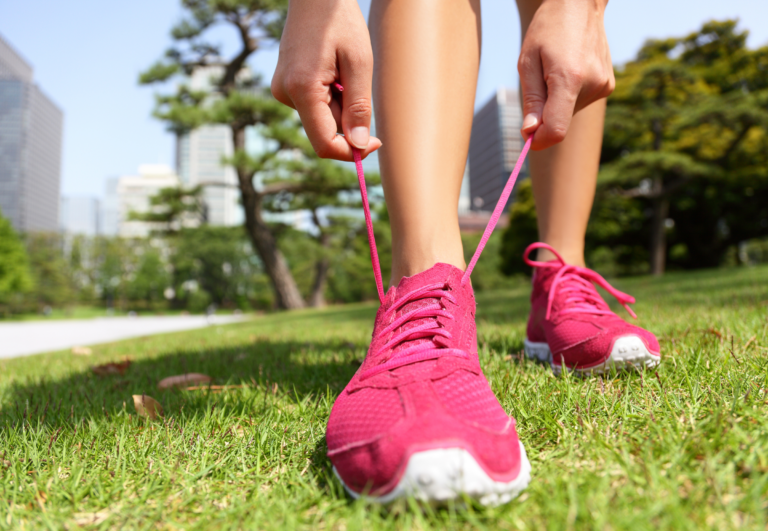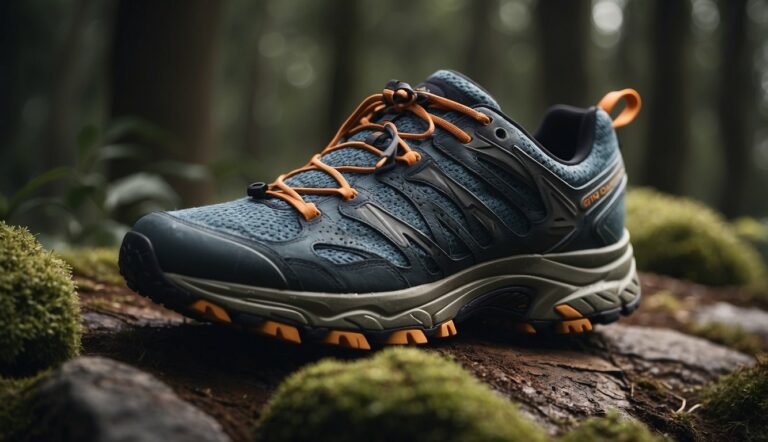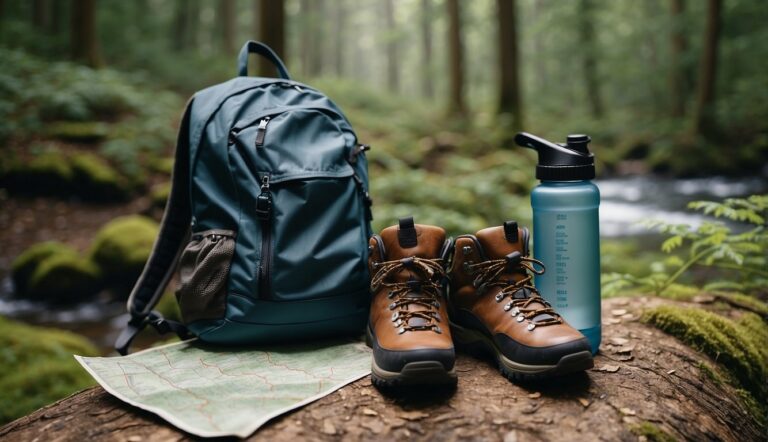What Makes Trail Running Shoes Different from Road Running Shoes? (Design & Features)
When you switch from the predictability of asphalt to the rugged variability of a trail, your shoes are the first to feel the brunt.
The difference between trail running shoes and road running shoes is engineered for your running experience and safety. Trail running shoes are built to tackle the obstacles you’ll meet in the wild: rocks, roots, and uneven terrain. They offer increased grip, protection, and stability so you can focus on your stride and scenery.
Your road running shoes, on the other hand, cater to the smoother, harder surfaces of cityscapes and parks. Designed for speed and efficiency, they focus on cushioning and responsiveness to absorb the repetitive impact of pounding on pavement. While they may share the same sport, road and trail shoes are as distinct as the environments they’re meant for.
As you lace up, it’s important to recognize these specialties to enhance your performance and comfort. Whether you’re navigating a rocky climb or bounding along a boulevard, choose the right shoe that aligns with the terrain and your unique running style. Remember, your shoes are more than just gear; they’re a key ally in your running journey.
Fundamental Differences Between Trail and Road Running Shoes

When choosing between trail and road running shoes, it’s essential to understand the specific features that define them and how they cater to different running surfaces. As an experienced runner, you know that the right shoe can make all the difference.
Materials and Durability
Trail running shoes are crafted with durable materials to withstand rough terrain. The uppers are typically reinforced to resist abrasion against rocks and roots, and they often include sturdy toe guards for added protection.
In contrast, road running shoes have lighter, more breathable materials, focusing on comfort and less on ruggedness because they need to handle repetitive strikes on smoother surfaces.
Outsole and Traction
The outsole of a trail running shoe is designed with larger, softer lugs for improved traction on uneven and slippery surfaces. These lugs are made of stickier rubber to grip terrain, such as mud and gravel.
Road running shoes, however, feature flatter and smoother outsoles made from more durable rubber to offer stability and longevity on hard, paved surfaces.
- Trail Running Shoe Outsole: Stickier rubber, aggressive lug pattern
- Road Running Shoe Outsole: Durable rubber, flat tread pattern
Midsole and Cushioning
Midsoles in trail running shoes are built to balance cushioning and stability. They often have a stiffer composition to protect your feet from uneven and rocky terrain. Road running shoes typically prioritize responsive cushioning to handle the continuous impact of hard surfaces.
- Trail Running Shoe Midsole: Firmer for protection; moderate cushioning
- Road Running Shoe Midsole: Softer for impact absorption; enhanced cushioning
Design and Structure of Trail Shoes

In my years of running experience, I’ve noticed key differences in the design and structure of trail and road running shoes that directly impact performance. Let me guide you through what sets them apart to help you make the best choice for your feet.
Protection and Stability
When you’re navigating rough terrain, the sturdy construction of a trail running shoe is your first line of defense. A rock plate incorporated in the sole protects your feet from sharp objects. The toe box is often reinforced to shield against stubbing on rocks and roots.
With uneven surfaces being a given, trail shoes have features like a rand—a protective band around the shoe—that secure the sides and upper of the shoe, providing lateral stability. The outsoles come with aggressive lugs for grip and are made of sticky rubber to help maintain your gait on slippery or loose surfaces.
Shoe Anatomy and Upper Construction
Upper Material: The upper of a trail running shoe typically uses breathable mesh combined with durable fabric overlays. This design choice balances the need for breathable uppers that keep your feet cool while offering protection against trail debris.
Construction: Trail shoes are often made with a gusseted tongue and might include a water-resistant layer to keep out moisture. They also usually sport a protective toe cap and might have a fitted gaiter to keep out small rocks and dirt.
Fit and Comfort Features
Comfort: Layering in comfort, trail shoes often have added cushioning to provide shock absorption. This helps mitigate the impact of running on rugged, unpredictable trails.
Lightweight Features: Despite their rugged build, trail shoes strive to remain lightweight without sacrificing protection. Advances in materials and design have allowed for a less bulky shoe that still offers ample support and protection.
By understanding the specific needs a trail shoe meets, you can better choose the right gear to keep you comfortable and stable as you tackle the trails.
Trail Shoe Performance on Varied Terrains

When you venture into the wilds of nature’s paths, the performance of your running shoes can make or break your experience. Let’s explore how trail and road running shoes differ in their approach to varied terrains.
Grip and Traction Control
Trail running shoes are designed with large lugs on their outsoles which offer you improved grip and traction control. These features ensure stability and safety on challenging surfaces like muddy paths, slippery rocks, and loose gravel.
- Mud: Deep lugs bite into the earth, keeping you stable.
- Snow: Similar to snow tires, the lugs grip onto slick surfaces.
Support and Foot Protection
A sturdy build is crucial when facing rugged trails, which is where trail running shoes shine. They have reinforced toe caps and robust materials that protect your feet from roots and rocks.
- Protection: The inclusion of a rock plate helps shield the sole of your foot.
- Support: Heavier and stronger materials offer better ankle stability.
Response to Weather and Trail Conditions
Trail shoes are made to endure the extremes of weather and trail conditions.
They provide consistent performance, whether you’re tackling wet, snowy, or gritty dirt trails.
| Condition | Feature |
|---|---|
| Wet and Muddy | Water-resistant materials |
| Dust and Dirt | Durable construction |
| Technical Terrain | Responsive cushioning for impact absorption |
Remember, your choice between trail and road running shoes should depend on where you plan to stride most often. Proper footwear will keep you running comfortably and safely on your chosen terrain.
Choosing the Right Trail Shoes for Your Needs

When selecting the appropriate footwear for running, it’s important to consider the specific characteristics of trail running shoes versus road running shoes. Your choice should be based on the type of terrain you’ll encounter, how the shoes fit your feet, and your individual preferences and running mechanics.
Trail Running Shoes for Different Terrains
Trail shoes are designed with diverse landscapes in mind. They feature aggressive tread patterns for grip on dirt, mud, and rocky trails.
- Soft, muddy trails: Look for shoes with widely spaced, large lugs to prevent mud build-up.
- Rocky, technical trails: Opt for shoes with a stiffer sole and enhanced toe protection.
How to Determine the Best Fit
The fit of your shoes plays a significant role in comfort and injury prevention.
- Size chart: Always refer to the brand’s size chart as sizing can vary between manufacturers.
- Gait and weight: Choose shoes that complement your gait, whether overpronation or a neutral stride, and consider cushioning based on your weight.
Personal Preference and Running Style
Your personal preference and running style should guide your final decision.
- Cushioning: Road running shoes often provide more cushioning, which is preferable if you enjoy a soft ride.
- Weight of the shoe: Trail shoes may be heavier due to added durability features; choose what feels comfortable for your running sessions.
Trail Shoe Types and Variations
As an expert in footwear, I can help you understand the differences between types of running shoes. Trail and road running shoes come in various forms to cater to your running style and the terrain you choose to tackle.
From Minimal to Maximum Cushioning
Minimal Cushioning: These trail running shoes have less padding, allowing your feet to feel the ground more, thus providing a more natural running experience.
Moderate Cushioning: A moderate level balances cushioning and ground feel, suitable for varied terrains.
Maximum Cushioning: Maximum cushioned shoes offer the most support and padding, which can be beneficial for long runs on rugged trails to reduce stress on your joints.
Heel-to-Toe Drop Variations
The heel-to-toe drop in shoes refers to the difference in height between the heel and the forefoot. Here is a brief breakdown:
- Low Drop (<4 mm): Encourages a more natural foot strike and is often found in minimal cushioning shoes.
- Medium Drop (4-8 mm): Provides a balance, often seen in moderate cushioning shoes and is good for a wide range of runners.
- High Drop (>8 mm): Common in maximum cushioning shoes and can be easier on the Achilles tendon for those who heel strike.
Specialised Shoes for Extreme Conditions
- Waterproof Shoes: These are designed with weather-resistant materials to keep your feet dry in wet conditions.
- Enhanced Traction: For rough terrain, look for shoes with deep lugs on the sole to grip the earth and prevent slipping.
- Durable Uppers: Created to protect against sharp rocks and trail debris, these can become essential in technical terrains.
By choosing the right shoe type and understanding the variations, you’ll enhance your running experience whether you’re on a smooth sidewalk or a mountain trail.
Practical Tips for Trail Runners

As an experienced runner with a wealth of knowledge on both road running and trail running, here are the essential tips you’ll need to make the most of your running experience, no matter the terrain.
Transitioning from Road to Trail Running
When you transition from running on pavement to embracing the trails, your first step is selecting shoes with stiffer midsoles for underfoot protection and stability on uneven terrain.
Look for trail running shoes that provide a secure fit to prevent your foot from shifting inside the shoe, especially in the midfoot area. Adjusting to trails also means learning to navigate varying inclines and natural obstacles, so start with shorter runs to build your biomechanics for trail conditions.
Maintaining Your Trail Running Shoes
Trail shoes require different care than road-running shoes due to exposure to dirt, debris, and possibly water. After each run, remove any lodged debris from the lugs on the outsole and let your shoes dry naturally if they’re wet.
Avoid direct heat sources. To prolong the life of your trail runners, rotate them with a road pair if you occasionally run on pavement, since trail shoe lugs can wear down faster on hard surfaces.
Preventing Injuries and Maximizing Performance
Injuries can happen when your body isn’t prepared for the demands of trail running. Incorporate flexibility and strength training into your routine to help prevent injuries. Opt for more breathable shoes with appropriate stiffness to support your feet without causing overheating.
Lastly, pay attention to the drop and cushioning of the shoe – a low drop can help with a more natural foot strike, while adequate cushioning will absorb shocks from both rocks and roots.
| Shoe Type | Midsole | Terrain | Ideal Use |
|---|---|---|---|
| Trail Running | Stiffer | Uneven, outdoor trails | Off-road running |
| Road Running | Less stiff | Pavement | Urban environments |
Remember, optimal performance comes as much from proper gear as from training, so make sure you equip yourself with the right shoes and knowledge to enjoy your run safely and effectively.
Brand and Model Insights

Drawing from extensive experience in running and shoe technology, let’s dive deep into the specifics of trail running shoe brands and how their popular models compare—pespecially when it comes to tackling challenging terrains like jagged rocks with the right rubber lugs for optimal grip.
Popular Trail Running Shoe Brands
When you’re in the market for trail-running shoes, you’ll encounter several reputable brands known for their quality and innovation. Saucony stands out with its Saucony Peregrine line, praised for its balance between responsiveness and rugged durability. Other notable brands include:
- Salomon: Renowned for their aggressive outsole designs ideal for technical trails.
- Brooks: Offers reliable traction and comfortable yet secure fit.
- Hoka One One: Known for their extra cushioning, suitable for long-distance trail runs.
- Asics: Delivers a minimalist feel with enough protection for various trail conditions.
Comparing Popular Models
When comparing models, consider what you value most for your run. Below is a table summarizing the features of some popular models from outstanding brands:
| Model | Brand | Key Features |
|---|---|---|
| Saucony Peregrine | Saucony | Versatile traction, secure fit, responsive cushioning |
| Speedcross | Salomon | Aggressive grip, precise foothold, lightweight construction |
| Cascadia | Brooks | Rugged durability, stable support, adaptable outsole |
| Challenger ATR | Hoka One One | Ample cushioning, versatile grip, comfortable upper |
| Gel-Scram | Asics | Trail-specific outsole, lightweight build, breathable mesh |
Each model brings to the trail a set of features tailored to enhance your running experience on rough terrain.
The Saucony Peregrine, for example, is often commended for its aggressive rubber lugs that provide confident footing amongst jagged rocks and slippery surfaces.
Additional Features and Technologies in Trail Shoes

As an experienced trail runner, you’re aware that the unpredictability of off-road surfaces calls for specialized features in your shoes. Trail running footwear is designed to provide you with the essential foot protection and stability so you can tackle any terrain with confidence. Let’s explore these additional features that set trail running shoes apart from their road running counterparts.
Enhanced Foot Security
Your trail running shoes are built with foot protection as a top priority. They often have synthetic overlays and a stable platform to keep your feet secure on inconsistent surfaces. For example:
- Toe Bumpers: Protects against stubbing and bruising from rocks and roots.
- Medial Posts: Offers added arch-side support for uneven terrain.
Lace Pockets ensure your laces stay tucked away, preventing them from getting caught on branches or debris. Additionally, many trail shoes include gaiter attachment points to prevent dirt and stones from entering the shoe.
Adaptive Materials and Shoe Technology
Trail shoes are constructed with adaptive materials that respond to a variety of outdoor conditions.
- Nylon and Mesh: These contribute to a breathable upper that can handle wet and dry conditions while providing durability.
Shoe Technology enhances the adaptability of the shoe to various terrains:
- Lugs: Provide traction on mud, gravel, and technical trails.
- Rock Plates: Incorporated into the midsole for protection from sharp rocks.
Here’s a quick comparison to give you a clearer picture:
| Feature | Function |
|---|---|
| Mesh Upper | Increases breathability and flexibility |
| Lugs on Outsole | Grips the terrain for better traction |
| Rock Plate | Shields your foot from rough ground |
Remember, next time you hit the trails, you’re not just stepping into a shoe, you’re gearing up with a range of technologies designed to conquer the path less traveled.
Environmental Impact and Sustainability

As someone experienced in the nuances of running gear, you’re likely aware that the choice of your shoes not only impacts your performance but also the environment. Let’s explore how the materials in trail running shoes and your running habits can play a part in sustainability.
Eco-Friendly Shoe Materials
Trail running shoes often make use of durable materials to withstand rough terrain. However, the production of these materials can have a significant environmental footprint. For example:
- Rubber: The soles of trail running shoes typically use broad rubber for better grip, which takes a long time to decompose.
- Mesh: For breathability and comfort, mesh, often made from nylon, is a common material in the upper part of these shoes.
Both rubber and nylon production contribute to carbon emissions, but companies are exploring eco-friendly alternatives—like recycled rubber and sustainable mesh fabrics—which help reduce the shoes’ overall environmental impact.
| Material | Sustainability Factor |
|---|---|
| Rubber | Often non-biodegradable, better if recycled |
| Nylon | High emissions, look for recycled varieties |
| Mesh | Increased breathability with less environmental impact if made sustainably |
Sustainable Running Practices
Your choice in running practices can also contribute to environmental efforts:
- Opt for shoes made with sustainable materials when possible.
- Look for brands that utilize recycled rubber and breathable mesh that doesn’t compromise the environment.
- Consider the longevity of your shoes to minimize waste; trail running shoes designed for durability can reduce the frequency of replacement.
| Practice | Sustainable Impact |
|---|---|
| Choosing sustainable materials | Reduces waste and emissions |
| Supporting eco-friendly brands | Encourages industry sustainability |
| Considering durability | Lessens turnover and resource use |
By choosing trail running shoes crafted with the environment in mind and adopting sustainable running habits, you directly contribute to lessening your ecological footprint.






